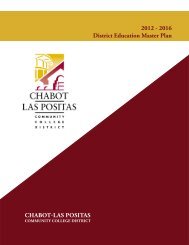City College of San Francisco - California Competes
City College of San Francisco - California Competes
City College of San Francisco - California Competes
Create successful ePaper yourself
Turn your PDF publications into a flip-book with our unique Google optimized e-Paper software.
THEME IV<br />
Finance/Accounting, and Admissions and Records. This intent was reflected in the Strategic Plan<br />
2003–2008. Of those four areas mentioned, it was felt that Admissions and Records (A&R) would be<br />
the best place to start a pilot effort because its effectiveness so directly impacted the quality <strong>of</strong> service<br />
to students.<br />
Various issues needed to be addressed. There were long lines at most campuses during registration times,<br />
even after telephone registration was implemented for credit classes. Student complaints still abounded<br />
about “being given the runaround,” as did problems in areas such as grading and transcripts. Time-consuming,<br />
inefficient processes which relied too heavily on manual paperwork were seen as sources <strong>of</strong> many<br />
delays. In an attempt to begin to address these issues, the Strategic Plan 2003-2008 included ambitious<br />
objectives and plans for making improvements in A&R. Those plans, originating in various sections <strong>of</strong> the<br />
Strategic Plan, called for a re-organization and re-engineering <strong>of</strong> the unit, with a streamlining <strong>of</strong> processes.<br />
Paper-based systems were to be converted to electronic systems at all campuses, and more efficient systems<br />
were to be implemented for both credit and noncredit. Transcript, transfer, and degree audit issues were to<br />
be addressed. In Spring 2003 the effort began to re-engineer A&R.<br />
The word “re-engineer” should not be taken lightly in this context. “Re-engineering a process” is <strong>of</strong>ten<br />
understood as a total re-design. 1 The sweeping, assume-nothing nature <strong>of</strong> a re-engineering initiative is probably<br />
the most challenging aspect <strong>of</strong> it, while the fact that ideal or optimal results are at least envisioned<br />
is also one <strong>of</strong> the main benefits <strong>of</strong> the process. The A&R Re-engineering initiative was typical in that it<br />
was a creative endeavor to stimulate out-<strong>of</strong>-the-box solutions.<br />
The Chancellor first discussed with administration the idea <strong>of</strong> doing a re-engineering study <strong>of</strong> A&R to<br />
see how to eliminate student frustration and complaints. The study process was set up, with consultants<br />
working with two CCSF teams assembled from teaching and counseling faculty and classified and<br />
administrative staff. Separate teams were established for credit and for noncredit. While steps toward<br />
re-engineering had begun prior to the study, the study advanced current steps and expanded into new<br />
developments. For example, the credit team identified various problems such as: lack <strong>of</strong> sufficient student<br />
service computers, multiple forms <strong>of</strong> storage used for records, Banner problems that delayed registration,<br />
late student payments, and occasional unacceptable delays in mailing transcripts. Examples <strong>of</strong> problems<br />
pointed out by the noncredit team included: paper intensive processes that did not make use <strong>of</strong> available<br />
technology, duplicate student records, enrollment and attendance that sometimes preceded admission,<br />
use <strong>of</strong> forms that varied by campus, and students enrolling in classes that were already full. The Dean<br />
<strong>of</strong> Admissions and Records sums it up: “The issue was to get rid <strong>of</strong> bottlenecks. How could we get students<br />
through this maze in a seamless fashion” All information provided by the teams was carefully documented<br />
and flow-charted by the facilitators. Both teams suggested changes and solutions. Dozens <strong>of</strong><br />
recommended solutions ranged from a one-stop student services facility at Ocean Avenue Campus,<br />
to electronic mailing <strong>of</strong> transcripts, better enforcement <strong>of</strong> payment policies, and use <strong>of</strong> a smart card<br />
for automated noncredit attendance reporting. The final report was then followed up by a list <strong>of</strong> ten<br />
Top Priorities for Implementation.<br />
1 Re-engineering typically involves engaging direct participatory input from the field; describing problems with the current<br />
process; analyzing the functions which are to be retained, assuming absolutely nothing based on past practice; determining the<br />
role that new technologies might play in improving the efficiency, cost, and effectiveness; designing a new process or<br />
flow which is optimally streamlined and better serves the organizational mission; implementing the re-engineered process;<br />
evaluating the functioning <strong>of</strong> the process; and adjusting the process in a cycle <strong>of</strong> continuing improvement. (Hammer, 1993)<br />
CITY COLLEGE OF SAN FRANCISCO<br />
297







